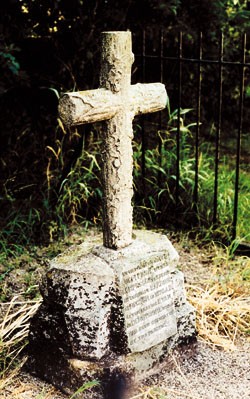Plague at Eakring?

ABOVE: The Mompesson Cross in the village of Eakring near Ollerton. The inscription reads "Near this spot stood Pulpit Ash where Mompesson preached on coming to Eakring as Rector in 1670 AD after leaving Eyam in Derbyshire which had been decimated by the Plague."
After surviving plague at Eyam in Derbyshire, the Rev. William Mompesson settled at Eakring in Nottinghamshire
The village of Eyam in the Peak District of Derbyshire is best known for its connection with the Great Plague of 1665-66.
The heroic exploits of the Rev William Mompesson in containing the plague still excites interest among the village's many visitors and the terror endured by this small, isolated community has become the mainstay of many a school history project up and down the country.
In the wake of such momentous events taking place across the county border, it is interesting to record Nottinghamshire's own connection with Mompesson when, in later life, he arrived to take up the position of rector in the parish of Eakring near Ollerton.
William Mompesson (1639 - 1709) was born in Seamer near Scarborough, the son of the Rev John Mompesson.
William followed his father into the church and after graduating from Peterhouse, Cambridge, in 1662 became domestic chaplain to Sir George Savile of Rufford Abbey in Nottinghamshire.
It was Savile who, two years later, appointed Mompesson to the rectory of Eyam. At that time the village lay at the heart of Derbyshire's important lead mining industry and by the standards of the day, Eyam was considered a vibrant and flourishing rural community.
Only a year after Mompesson's arrival, however, in September, 1665, tragedy struck as plague-bearing fleas bound up on a parcel of cloth from London were unwittingly released among the inhabitants.
The contagion spread quickly through the village, and as he ministered to the stricken families, Mompesson became only too familiar with the tell-tale signs which foreshadowed each plague death - a sharp rise in body temperature, bouts of uncontrollable shivering and vomiting and the alarming growth of swellings or buboes in the lymph nodes of the armpits and groin.
Death usually followed within a matter of hours. Mompesson quickly realised the dangers posed to neighbouring communities if the plague was allowed to spread and it was he who instigated the successful quarantining of the village which did so much to safeguard the lives of others in the vicinity.
The villagers were persuaded not to stray beyond the parish bounds, with food from outside being left in wells or troughs of running water along the parish boundary.
Believing that the confined atmosphere of his own church might hasten the spread of the disease, Mompesson took to preaching in the open air.
Mompesson's strategy worked and undoubtedly saved the fate of many in the surrounding villages in that part of Derbyshire.
The cost to Eyam, however, was devastating. Of the 350 or so who had remained in the village after the initial outbreak only 83 survived. "I may truly say," wrote Mompesson in a letter to his uncle in the summer of 1666, "our town has become a Golgotha, a place of skulls."
Mompesson survived the plague, but his wife was not so lucky. She died only weeks before the colder weather of autumn 1666 finally began to kill off the plague-carrying fleas.
After three further years helping the villagers rebuild their shattered community, Mompesson was relieved of his post in Eyam and transferred by Lord Savile to the somewhat quieter parish of Eakring.
It was here that Mompesson lived for the rest of his life.
Three years had passed since the plague had subsided at Eyam, yet Mompesson found that the inhabitants were still so fearful of infection that at first he was refused entry to the village.
He was obliged to live in a small house or hut which was erected for him in the park at Rufford. Similarly, he once again found himself preaching in the open air, this time from beneath a large ash tree at the edge of the village which subsequently became known as the Pulpit Ash.
There has been some suggestion that Mompesson's outdoor services at Eakring were actually a result of the dilapidated state of the parish church.
Whatever the circumstances, however, such inconveniences could only serve as minor hiccoughs in an incumbency which spanned more than 30 years, and in which Mompesson proved himself to be a true beneficiary of the village.
He did good work in helping to restore the village church (adding the side porches, font and pulpit) and in 1676 was made a prebendary of Southwell (and later of York).
He involved himself vigorously in the process of rebuilding the prebendial houses of Southwell which was necessitated by damage caused during the time of the Rebellion. He is said, however, to have refused further advancement to the Deanery of Lincoln in favour of a desire to lead a quiet life.
William Mompesson died at Eakring in 1709 aged 70. He was buried in the chancel of the parish church where there is a brass plate and three small windows to his memory.
In 1893 Lord Savile of Rufford Abbey erected a stone cross on the site of the Pulpit Ash to commemorate the unusual circumstances which had surrounded Mompesson's arrival in Nottinghamshire. It remains to this day, neatly kept and tended, an enduring memorial to a most unassuming but remarkable man.